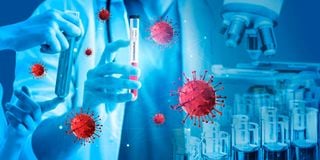Broaden scope of research to beat Covid-19

Covid-19 medical test vaccine research and development concept.
What you need to know:
- While Covid-19 infections and death rates continue to rise, the availability of vaccines has mitigated the effects of the pandemic.
- Vaccination aims to provide herd immunity, which will reduce the susceptible opportunities for the virus.
It is well established that the Covid-19 pandemic is a zoonotic disease, having been caused by a virus that jumped from bats to humans. Historically, global pandemics follow a predictable path: a pathogen spills over from wild animals to a human victim then spreads rapidly.
This is the path that coronavirus followed, infecting over 200 million people, resulting in more than 4.5 million deaths worldwide, so far.
Wild organisms that harbour and provide suitable environment for infectious pathogen to reproduce are known as natural reservoirs. Usually, a pathogen lives in its natural reservoir without causing any infection.
However, when the natural habitat of the reservoir is disturbed, there is an exposure to other organisms. This provides an opportunity to leap to new hosts and humans have been at the receiving end. This is due to the role they play in the manipulation of natural habitats for socioeconomic gains. A pathogen could also lurk in other organisms – intermediate reservoirs – humans interact with often.
Vaccination campaigns
While Covid-19 infections and death rates continue to rise, the availability of vaccines has mitigated the effects of the pandemic. Vaccination aims to provide herd immunity, which will reduce the susceptible opportunities for the virus.
As vaccination campaigns intensify, it would be prudent to investigate the presence of the virus in other organisms, domestic and wild, that could serve as intermediate reservoirs. This could be consequential in that, under favourable conditions, the virus could leap back to humans and cause infections. Being a zoonotic pathogen, the likelihood of coronavirus’ re-emergence, even long after it’s thought to have been wiped out, is possible.
Therefore, determining its presence in other organisms is a crucial surveillance mechanism. It would involve collecting various samples, including internal tissues, blood, oral and respiratory swabs, from organisms that exist in close proximity to humans.
Screening of these samples for coronavirus specific antibodies is crucial. Should there be organisms found infected or harboring the virus, vaccination would avert the risk of it crossing back to humans. With demand for vaccines far outweighing supply, it is logical that humans take the jabs first.
Dr Kerima (PhD) is a biochemist. [email protected]; @KerimaZablon





